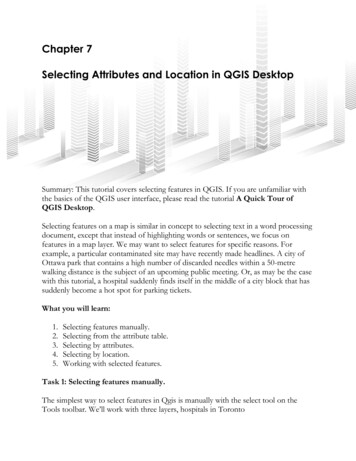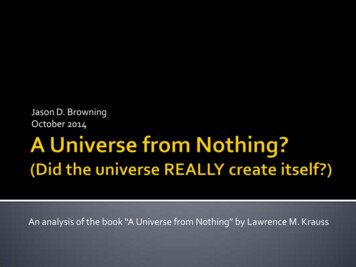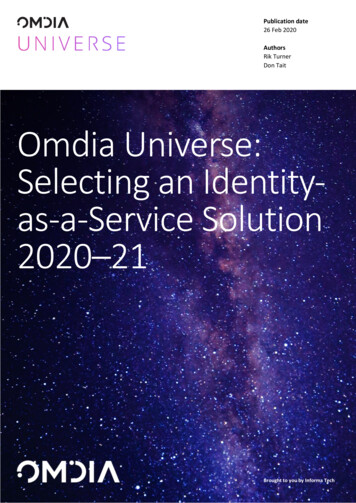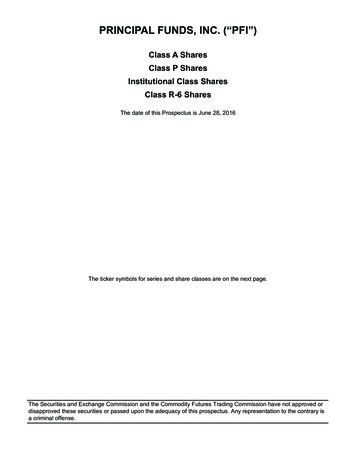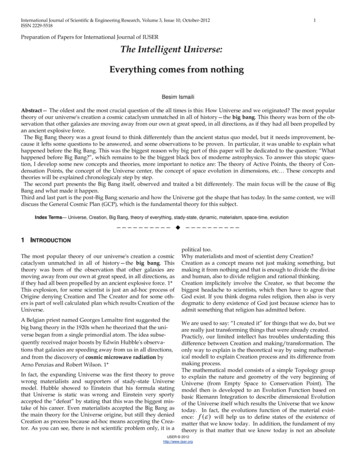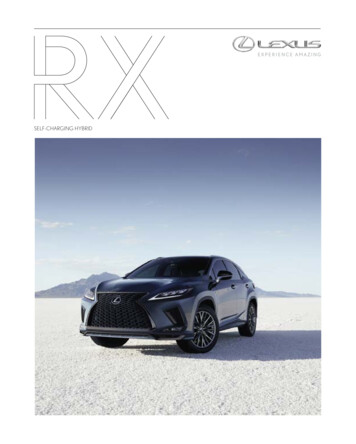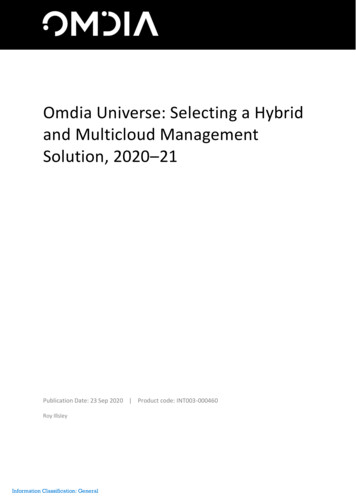
Transcription
Omdia Universe: Selecting a Hybridand Multicloud ManagementSolution, 2020–21Publication Date: 23 Sep 2020 Product code: INT003-000460Roy IllsleyInformation Classification: General
Omdia Universe: Selecting a Hybrid and Multicloud Management Solution, 2020–21SummaryCatalystThe role and purpose of IT in organizations is undergoing significant change, driven by the need forbusinesses to become more agile. This report provides a side-by-side comparison and evaluation ofleading hybrid and multicloud management solutions, with the findings delivered as the OmdiaUniverse (see Figure 1). It considers the significance of management in a hybrid and multicloudworld to support the business requirement for agility.Figure 1: The Omdia Universe for hybrid and multicloud managementSource: OmdiaOmdia viewThe challenges of managing cloud resources and services has become a much greater part of the ITdepartment’s role and responsibility over the past 10 years. The use of cloud computing iscontinuing to grow as organizations look for more agile approaches to IT delivery of applications,workloads, and services. Initially, many organizations adopted cloud for business productivity and Omdia. All rights reserved. Unauthorized reproduction prohibited.Information Classification: GeneralPage 2
Omdia Universe: Selecting a Hybrid and Multicloud Management Solution, 2020–21customer-facing applications, but increasingly, the types of applications and workloads moving to acloud environment are changing to include core systems such as ERP, CRM, and so on. While it istrue that the cloud is not the ideal environment for every workload/application, it is now becomingthe accepted norm that a cloud-first strategy is more common.As the type of workload/applications moving to the cloud is changing so is the expectation of whatthe cloud provider must deliver to meet business needs. This increased demand for resiliency,protection, and service continuity has seen the growth of hybrid cloud environments. The hybridcloud is not a singularity; it is a construct that enables bridges between clouds to be built so as tosupport workloads/applications that require on-premises deployment. The cloud providers areextending the operational and functional benefits of their cloud platforms to customer premises.The goal is to make it easier for enterprises to take advantage of cloud services. The motivation is todrive more traffic and revenue to the cloud and to capture those customers that have previouslybeen reluctant to move core applications to the cloud because of regulation and compliancerequirements.Key messages For the second successive report, VMware is the clear leader in the Omdia Universe, scoringan overall average of 80.80% across all three dimensions. Microsoft, IBM, Google, and Oracle are also classified as leaders, all scoring an average ofover 70%. The other distinction was that the leaders were responsible for 95% of the 16subcategory-leading scores. The challengers’ performance ranged from an average score of 67% to just below 70%, butthe key differentiator was that no challenger recorded more than one subcategory-leadingscore. The prospects all showed significant promise as solutions that are being developed.Prospects are characterized as having some gaps in their capabilities that are still a work inprogress.Analyzing the hybrid and multicloud managementuniverseHow to use this reportOmdia is a proud advocate of the business benefits derived through technology, and hybrid andmulticloud management is at the forefront of realizing benefits to marketers across the globe. TheOmdia Universe report is not intended to advocate an individual vendor but rather to guide andinform the selection process to ensure all relevant options are considered and evaluated in anefficient manner. By using in-depth reviews on TrustRadius to derive insights about the customerexperience, together with the analyst’s knowledge of the market, the report findings gravitatetoward the customer’s perspective and likely requirements, characteristically those of a mediumlarge multinational enterprise (5,000-plus employees). Typically, deployments are considered across Omdia. All rights reserved. Unauthorized reproduction prohibited.Information Classification: GeneralPage 3
Omdia Universe: Selecting a Hybrid and Multicloud Management Solution, 2020–21the financial services, TMT (technology, media, and telecoms), and government sectors, on a globalbasis.Market definitionIn this report, Omdia developed a series of features and functionality that would revealdifferentiation between the leading solutions in the marketplace. The criteria for hybrid andmulticloud management are as follows: Monitoring: this looks at a solution’s ability to monitor resource usage and its impact onperformance. In the 2020–21 report, monitoring is extended beyond just performancemonitoring to include mobile, services, and containers technologies. Private cloud management (server, network, storage, I/O): this includes the ability tomanage all aspects of the infrastructure delivery chain from server, network, storage,endpoint, to I/O. Public cloud management: this considers how well the solution integrates with other cloudsolutions, allowing not only visibility into resource usage, but control and management ofthose environments. Service modeling and financial management: one of the biggest challenges for any CIO isbeing able to predict future resource needs by type and delivery method. This section looksat how well the solutions allow for modeling and support “what-if” analysis. An increasinglyimportant, if underrepresented, capability is that of managing the cost and financial aspectsof delivering services to line-of-business customers. Operational management (scale, delivery, provisioning): this examines the ability tomanage at scale across different geographies and technologies. Security management (DevSecOps): the rise of DevSecOps has changed how the IToperations function thinks about the management of applications. This section focuses onhow well the solutions support the concept of security and lifecycle management and alignwith any DevSecOps approach. Backup and resiliency: the ability to secure and protect data should be implicit in anysolution. Although these solutions are primarily seen as backup and recovery solutions, theymust be able to perform basic data protection and support security integrations. Lifecycle management and automation: the need to automate as many operationalactivities as possible aligns with the CIO’s need to reduce costs. This section looks at how thesolutions enable different levels of automation. Reporting and integration:this capability is the need to produce more than the standardweekly resource usage report. This section evaluates the solution’s ease of integration withother data sources and how user friendly its reporting capabilities are. Marketplace management: this evaluates the ability to operate and manage theapplications and services that customers can select and deploy to the cloud from amarketplace. Omdia. All rights reserved. Unauthorized reproduction prohibited.Information Classification: GeneralPage 4
Omdia Universe: Selecting a Hybrid and Multicloud Management Solution, 2020–21Market dynamicsChanges from previous reportOne of the most obvious changes in the market since the previous report ( Omdia Decision Matrix:Selecting a Hybrid and Multicloud Management Solution, 2018–19) is the number of vendors takingpart has reduced from eleven to nine. This reduction in the market is due to a number of factors: 1.Mergers and acquisitions in the market have reduced the number of vendors. This trendhas been driven by the increased breadth of requirements, forcing specialist vendors to beacquired and incorporated into fewer bigger vendor offerings. For example, Red Hat’scapabilities are now incorporated into IBM’s offering, Micro Focus is now part of HPE’ssubmission, CloudHealth was acquired by VMware, and CliQr is now fully integrated intoCisco. 2.The multicloud inclusion criteria of this report eliminated a number of those vendors withonly proprietary management solutions for either single on-premises private cloud or asingle public cloud.Key market trendsThe growth of hybrid cloud is seen as pivotal to the wider adoption of cloud computing, because itenables organizations to begin their journey to cloud computing in a way that matches theirstrategy. However, different cloud providers have taken different approaches to support theenterprise demand for hybrid cloud solutions: Amazon Web Services (AWS), Microsoft, and Oracle have developed proprietary edge andhybrid cloud appliances. Google and IBM have software solutions based on a platform-agnostic container-basedenvironment.The two approaches to enabling distributed cloud workloads are not exclusive. The proprietary cloudplatform of the cloud providers also supports open source container-based application deploymentand management. However, the management is much more rudimentary than with the softwarebased platforms developed with the open source community. The hardware/appliance approach iswitnessing cloud providers working with hardware OEMs to deliver edge and hybrid cloudinfrastructure solutions for their own clouds.The management challenges faced by IT departments are amplified as organizations adopt differentpublic clouds and different hybrid cloud approaches. The complication is that organizations areselecting the cloud environments based on factors such as cost, resiliency, regulatory compliance,service disruption, and security to match the persona of the workloads/applications. Omdia. All rights reserved. Unauthorized reproduction prohibited.Information Classification: GeneralPage 5
Omdia Universe: Selecting a Hybrid and Multicloud Management Solution, 2020–21Table 1: Vendor rankings in the Omdia Universe for hybrid and multicloud managementVendorProduct(s) evaluatedLeadersGoogleGoogle Cloud Operations, Cloud Deployment Manager,Cloud Console, Cloud Shell, Cloud Console Mobile App,Cloud APIs, AnthosIBMIBM Cloud Pak for Multicloud ManagementMicrosoftAzure Automation, Azure Advisor, Azure Backup and AzureSite Recovery, Azure Lighthouse, Azure Migrate, AzureMonitor, Azure Portal, Azure Resource Manager, Azure Arc,Azure Stack, Azure Cost ManagementOracleOracle Enterprise Manager, Oracle Cloud (services coveringmanagement, observability, security, database, applicationdevelopment, and marketplace)VMwarevRealize Suite, Tanzu Observability by Wavefront,CloudHealth, SkylineChallengersCiscoCisco CloudCenterHPEGreenLakeServiceNowITOM Operator EnterpriseProspectsManageEngineCloud Spend, Site 24x7Source: OmdiaMarket leadersThe market leaders all scored an average across all three dimensions of greater than 70%, and theyaccounted for 95% of the subcategory-category leading scores. The leaders also demonstrated abreadth of capability with only 20% of the recorded below-subcategory-category average scores. Theother criterion for being a leader was being within 11% of the overall leader’s score.Market challengersThe challengers all scored between 67.53% and 69.31% and were characterized as solid performerswith the gap between their performance and that of the leaders (except VMware) being a matter offine margins. Omdia considers that the market is in transit and is shifting its emphasis from a Omdia. All rights reserved. Unauthorized reproduction prohibited.Information Classification: GeneralPage 6
Omdia Universe: Selecting a Hybrid and Multicloud Management Solution, 2020–21technical management capability to a services-centric approach. The challengers to different degreesall demonstrated a strong performance in the service management aspects.Market prospectsThe market prospects all scored below 60% on average and were characterized as being solutions indevelopment. The prospects provided strong capabilities in a few subcategories, which werematched by weaknesses in other subcategories. However, Omdia believes that the prospects all havedevelopment plans for evolution of the solutions.Market outlookThe market in hybrid and multicloud management is growing at a CAGR of over 22% between 2018and 2023, according to Omdia’s Software Market Forecasts: Infrastructure, 2018–23. Omdiaforecasts the market will be worth more than 14 billion by 2023, with North America the largestmarket, accounting for 5.6 billion (see Figure 2). To put this in context, the infrastructuremanagement market is forecast to be worth just over 2 billion by 2023, with North America againthe largest market, accounting for almost 700 million. Further evidence of the move to cloud isprovided by an analysis of the infrastructure spending by IT departments. In 2019 the averagepercentage of the IT budget spent on server and storage was 4.65%, compared to 7.85% spent oncloud (infrastructure as a service [IaaS], platform as a service [PaaS], and software as a service[SaaS]). The forecast is for this gap to widen as IT budgets in enterprise organizations reducespending on physical infrastructure, a trend accelerated by the COVID-19 pandemic.Figure 2: Omdia market forecast for hybrid and multicloud managementSource: Omdia Omdia. All rights reserved. Unauthorized reproduction prohibited.Information Classification: GeneralPage 7
Omdia Universe: Selecting a Hybrid and Multicloud Management Solution, 2020–21Vendor analysisOracle (Omdia recommendation: Leader)Products: Oracle Enterprise Manager, Oracle Cloud (services coveringmanagement, observability, security, database, application development,and marketplace)Oracle should appear on your short list because of its strong automationcapabilitiesFigure 9 shows the high-level performance of Oracle, which is classified as a leader in the hybrid andmulticloud universe with an average score of 72.51%. Oracle was joint leader in the capabilitydimension with an average score of 73%, which demonstrates the consistency of Oracle’sperformance. Oracle’s strongest capabilities were in the lifecycle and automation (87%),marketplace and applications (81%), and security management (80%) subcategories. Its weakestcapability was service modeling and financial management (54%). Omdia. All rights reserved. Unauthorized reproduction prohibited.Information Classification: GeneralPage 8
Omdia Universe: Selecting a Hybrid and Multicloud Management Solution, 2020–21Figure 9: Omdia Universe ratings: OracleSource: OmdiaAutomation is a key strength of Oracle and runs through a number of the subcategories. OracleCloud provides two defined autonomous services: Autonomous Database and Autonomous Linux.The Oracle Autonomous Database Cloud (OADC) is a new concept that Oracle introduced in 2018/19.The OADC is built using AI and ML and is designed to improve availability while reducing the cost ofmanaging these complex assets. Initially, the OADC provided a solution for data warehousedeployments; it was then expanded to cover OLTP, NoSQL, and Graph use cases. The core premise ofOADC is to transform the way databases are managed when they move to cloud to improve somechallenging operational activities such as tuning databases to ensure optimum performance, Omdia. All rights reserved. Unauthorized reproduction prohibited.Information Classification: GeneralPage 9
Omdia Universe: Selecting a Hybrid and Multicloud Management Solution, 2020–21patching and updating databases to ensure security and compliance, and autoscaling databases tomeet business demand.Omdia considers the integration of any management solution to the service desk to be a criticalcapability. While it is not a capability that many see as initially significant, its importance becomesobvious as organizations begin to consider the day two activities. At this stage, service deskintegration is a business imperative if service quality is to be maintained and measured. Service deskintegrations provided by Oracle include sharing data with Jira, Slack, ServiceNow, Grafana, BMCRemedy Service Desk, CA Service Desk, HP Operations Manager, HP Service Manager, IBM TivoliNetcool/OMNIbus, and Microsoft Systems Center Operations Manager.Oracle’s strength in marketplace and applications was due to a combination of capabilities. Oracledelivers a number of different solutions that can be used to deliver the marketplace capabilitiesrequired. The weakness of Oracle’s approach was that it is predominantly an Oracle marketplacesolution, but the addition of the Oracle Cloud Registry is beginning to change that approach. OracleCloud Console has a capability that enables customers and partners to create, edit, and configurelistings in the Oracle Cloud Marketplace. Omdia notes that the generation of listings requires Oracleapproval before they are publicly accessible. Omdia liked the capabilities provided by Oracle CloudRegistry, which provides access to a Docker Registry for public and/or private use. Oracle alsoprovides Oracle Linux Container Registry, which is accessed from inside Oracle Linux, placing thecontrol in the hands of developers. The overall marketplace capability that Oracle EnterpriseManager provides is access to a private cloud marketplace via a self-service portal.In terms of making the marketplace simple and easy to use and manage, the use of automation iskey. Oracle Cloud performs automation based on Terraform and Resource Manager Stacks, whichcan be integrated with other DevOps toolsets such as Hudson, Jenkins, Puppet, and Chef. One of theoptions available with Oracle is customer-managed environments. In these environmentsautomation can be delivered in two ways: Oracle Enterprise Manager Patch Plans offer a quick, easy, and reliable patching mechanismthat is facilitated using patch plans in Cloud Control. Ksplice updates the Linux OS kernel and key user space libraries while the OS is running,without a reboot or any interruption.Both of the options can be invoked by external DevOps tool sets using different interface approachessuch as, for example, APIs or command-line interfaces (CLIs).Oracle’s third-biggest strength was its security management capabilities. The key to Oracle’sstrength is the approach it takes to security. Oracle engineers security into its platform and providessecurity in depth. It is how these security capabilities are surfaced that enables Oracle to scoreabove the cohort average. Omdia liked the fact that Oracle provides a wide array of security-specificofferings with each of its technology solutions. For example, database security is provided via thevarious security options such as transparent data encryption, audit vault, database firewall, and datamasking. Oracle Enterprise Manager provides configuration and compliance management, which canbe used as part of a comprehensive security posture activity. Identity and access management isprovided by Oracle IdM on-premises and Oracle Identity Cloud Services in Oracle Cloud. Oracle alsoprovides additional comprehensive capabilities in Oracle Cloud for intrusion detection, distributed Omdia. All rights reserved. Unauthorized reproduction prohibited.Information Classification: GeneralPage 10
Omdia Universe: Selecting a Hybrid and Multicloud Management Solution, 2020–21denial of service (DDoS) mitigation, identity and access management, threat detection, keymanagement, and so on.Oracle’s weakest capability was service modeling and financial management. Oracle’s solution isaimed at the IT operations team, and the financial information provided is limited to the informationneeded by this team. One key weakness is Oracle Enterprise Manager’s chargeback function, whichcan contain general ledger information, but this is manually entered by administrators. The ability toshow comparative cloud cost is also missing from Oracle’s solution. However, Omdia accepts that acloud provider showing cross-cloud cost management data might not be a trusted source ofinformation: customers are seeking an independent perspective on cloud costs.MethodologyOmdia UniverseThe process of writing a Universe is time consuming: Omdia analysts perform an in-depth review of the market using Omdia’s market forecastingdata and Omdia’s ICT Enterprise Insights survey data. Omdia creates a matrix of capabilities, attributes, and features that it considers to beimportant now and in the next 12–18 months for the market. Vendors are interviewed and provide in-depth briefings on their current solutions and futureplans. Analysts supplement these briefings with other information obtained from industry eventsand user conferences. Analysts derive insights on the customer experience with each solution via reviews andratings on TrustRadius. The Universe is peer reviewed by other Omdia analysts before being proofread by a team ofdedicated editors.Omdia ratings Market Leader. This category represents the leading solutions that Omdia believes areworthy of a place on most technology selection short lists. The vendor has established acommanding market position with a product that is widely accepted as best of breed. Market Challenger. The vendors in this category have a good market positioning and areselling and marketing the product well. The products offer competitive functionality andgood price-performance proposition and should be considered as part of the technologyselection. Market Prospect. The solutions in this category provide the core functionality needed buteither lack some advanced features or suffer from a low customer satisfaction rating.The scoring for the Universe is performed by independent analysts against a common maturitymodel, and the average score for each subcategory and dimension is calculated. The overall positionis based on the weighted average score, where each subcategory in a dimension is allocated a Omdia. All rights reserved. Unauthorized reproduction prohibited.Information Classification: GeneralPage 11
Omdia Universe: Selecting a Hybrid and Multicloud Management Solution, 2020–21significance weighting based on the analyst’s assessment of its relative significance in the selectioncriteria.Inclusion criteriaThere are many vendors in the IT management market offering solutions to customers of all sizes.However, inclusion in this Universe is based on the vendor’s ability to offer solutions specifically forthe hybrid and multicloud management aspects of data center management. All the vendors haveverified the accuracy of the data. As is typical with these projects, some vendors are unable to meetthe strict deadlines for the return of submissions so decline to participate.The criteria for inclusion of a vendor in the Universe for Hybrid and Multicloud Management, 2020–21 are as follows: The vendor must be a global vendor with customers in all of three regions: Asia Pacific;Europe, the Middle East, and Africa; and North America. A solutions vendor must offer cloud management capabilities that enable the managementof platforms/infrastructure other than its own technology. A software vendor’s solution must be capable of managing more than just servervirtualization. It must cover at least three of the four main areas (compute, storage,network, and applications). The vendor must have at least 250 customers, and they must be a mix of midsize enterprises(1,000–4,999 employees) and large enterprises (5,000-plus employees).Exclusion criteriaThe hybrid and multicloud management market is considered a new and evolving managementmarket, and Omdia accepts that some vendors have entered this market from different backgroundssuch as infrastructure management, services management, or cloud. Vendors and products areexcluded from the analysis according to the following criteria: The vendor’s solution is only applicable to five of ten different classifications in the capabilitydimension: monitoring, private cloud management (server, network, storage, I/O), publiccloud management, service modeling and financial management, operational management(scale, delivery, provisioning), security management (DevSecOps), backup and resiliency,lifecycle management and automation, reporting and integration, and marketplacemanagement. More than 50% of the vendor’s solution is made up from partner solutions or third-partysolutions. The vendor has no direct contact with the end customer; everything is done through channelpartners. Omdia. All rights reserved. Unauthorized reproduction prohibited.Information Classification: GeneralPage 12
Omdia Universe: Selecting a Hybrid and Multicloud Management Solution, 2020–21AppendixFurther readingReviews of Cloud Management Suites on TrustRadiusOmdia Market Radar: Hyper-converged Infrastructure 2019/20, INT003-000253 (December 2018)Omdia’s Cloud Economics Self-Assessment Model, IT0022-000938 (May 2017)Software Market Forecasts: Infrastructure, 2018–23, PT0192-000001 (September 2019)Understanding the complexities of cloud economics, IT0022-000937 (May 2017)AuthorRoy Illsley, Chief Analyst, IT Operations & Ecosystemaskananalyst@omdia.comCitation PolicyRequest external citation and usage of Omdia research and data via citations@omdia.com.Omdia ConsultingWe hope that this analysis will help you make informed and imaginative business decisions. If youhave further requirements, Omdia’s consulting team may be able to help you. For more informationabout Omdia’s consulting capabilities, please contact us directly at consulting@omdia.com.Copyright notice and disclaimerThe Omdia research, data and information referenced herein (the “Omdia Materials") are thecopyrighted property of Informa Tech and its subsidiaries or affiliates (together “Informa Tech”) andrepresent data, research, opinions or viewpoints published by Informa Tech, and are notrepresentations of fact.The Omdia Materials reflect information and opinions from the original publication date and notfrom the date of this document. The information and opinions expressed in the Omdia Materials aresubject to change without notice and Informa Tech does not have any duty or responsibility toupdate the Omdia Materials or this publication as a result.Omdia Materials are delivered on an “as-is” and “as-available” basis. No representation or warranty,express or implied, is made as to the fairness, accuracy, completeness or correctness of theinformation, opinions and conclusions contained in Omdia Materials.To the maximum extent permitted by law, Informa Tech and its affiliates, officers, directors,employees and agents, disclaim any liability (including, without limitation, any liability arising fromfault or negligence) as to the accuracy or completeness or use of the Omdia Materials. Informa Techwill not, under any circumstance whatsoever, be liable for any trading, investment, commercial orother decisions based on or made in reliance of the Omdia Materials. Omdia. All rights reserved. Unauthorized reproduction prohibited.Information Classification: GeneralPage 13
CONTACT USomdia.comaskananalyst@omdia.com
businesses to become more agile. This report provides a side-by-side comparison and evaluation of leading hybrid and multicloud management solutions, with the findings delivered as the Omdia Universe (see Figure 1). It considers the significance of management in a hybrid and multicloud world to support the business requirement for agility.


